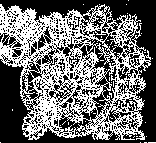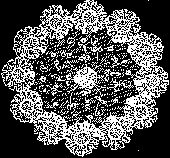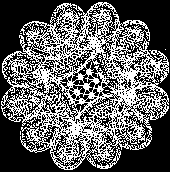|
|
|
|
 |
|
LACE BELGIUM
|
|
|
|
|
|
|
The different types of Belgian lace
|
|
|
A. Duchesse lace
|
|
|
This type of lace is manufactured on a "carreau" or cushion - taken from the Flemish word "kussen"-, on which the paper pattern is pinned. This pattern is the design to be realized in lace. The lacemaker generally works with 22 bobbins, two of which are called The Conductors.
The more complicated the design, the more bobbins have to be used. For a Binche "Point de Fée" up to 200 bobbins have to be utilized.
The conductors are woven from left to right, and from right to left. The end of the row having been reached, the thread is held in place with a pin. The conductor's threads form the weft of the work, while the other bobbins form the warp, or the vertical threads of the design. To make the corner of a handkerchief, the lacemaker will have to work for about three days, depending upon her level of skill.
|
|
|
|
 |
|
|
|
|
|
|
B. Rosepoint lace
|
|
|
This type of lace is made with a needle. It is considered to be the most delicate and precious of all laces. The pattern is first designed on paper, often reinforced with a piece of tissue, on which the design is realized. The design usually represents a rose or some other flower. To start, the lacemaker elaborates the flower's outline with a thicker thread, so to add relief to the work. The next stage is to fill in the interior of the flower design with much finer thread and a variety of different stitches. A fine handkerchief medallion takes three days' work. To produce larger pieces, all the medallions are sewn together with a thread so fine that it can only be detected by the eye of an expert. A certificate dating from 1922 states that the veil made for Queen Elizabeth required 12,000 of work and is made up with 12,000,000 stitches.
|
|
|
|
|
|
|
C. Princess lace
|
|
|
 |
This type of lace is still manufactured today and is mainly used for wedding veils, christening dresses, mantillas, and other ceremonial occasions. Nowadays, the net is made by machine. The flowers, stalks, and leaves are applied on the net by hand with a needle. In former times the net was also handmade, either by needle or by bobbins. This handmade net was given the Dutch name " Drochel ".
|
|
|
D. Renaissance lace
|
|
|
Renaissance Lace is also called Brussels Lace or Ribbon Lace. This is the lace that today is manufactured on a larger scale. It is a very strong lace used for house linen, such as, tablecloths, napkins, place mats, doilies, runners etc...
Again the pattern is drawn on paper. First the lacemaker will sew the ribbon onto the paper following the design. Then she will fill up the empty spaces with a needle using a variety of stitches. The paper is not pierced, the result being that only the paper and the ribbon are attached to one another. Finally when all the empty spaces are filled in, the tacking thread is cut on the back of the paper , the item of lace is removed and the paper pattern can be used again. The result is a finished item of lace, a corner, border, or a centrepiece, which may be then applied on Flemish linen to finish tablecloths, place mats, handkerchiefs, and a variety of other pieces.
|
|
 |
|
|
|
Everything about Lace from Belgium and Belgian Lace
On this site you'll be able to buy some of
the most incredible lace made products.
Opening soon !
Homepage - History of lace in Belgium
|
|
|
|
|
|
|
|
|
|
|
|
|
|
|
|
|
|
|
|
|
|



